Featured Application
The ultimate purpose of this study is to treat waste compounds via a simple hot-pressing approach to produce useful materials that can be used again. As a result, this study attenuates the negative influences of plastic waste on the environment while achieving sustainable development.
Abstract
With appropriate conditions, thermoplastic materials possess a good reversible ability. They are prone to exceed the reversibility range when being repeatedly processed as they cannot bear high temperatures. Therefore, this study aims to explore the impacts of the melting–recycling cycles and the presence of a compatibilizer on the omnipresent thermoplastic materials. Additionally, the tensile properties, morphology, and thermal properties are studied. The feasibility of multiple utilizations and differentiation effects are examined afterward. In this study, recycled or mechanically damaged thermoplastic polyurethane (T)/polypropylene (P) waste blends are used as the raw materials for the hot-pressing cycle, while maleic anhydride grafted polypropylene (MA) is used as the compatibilizer, thereby simulating the waste compounds. Next, the T/P/MA blends that undergo post-2nd and post-3rd recycling are evaluated for comprehensive change. The test results indicate that without MA, T/P blends exhibit significant differentiation effects due to an increase in the polypropylene content and multiple melting–recycling cycles. By contrast, the presence of MA mitigates the overall differentiation effect of T/P blends. The ultimate purpose of this study is to treat waste compounds via a simple hot-pressing approach to produce useful materials that can be used again. As a result, this study attenuates the negative influences of plastic waste on the environment while achieving sustainable development.
1. Introduction
In the late decades, plastic products have been commonly used in different regions because of abundant sources, low cost, ease of processability, and great diversity [1,2]. Worldwide, the annual production of plastics is approaching more than 300 million tons, and it is predicted that the global growth of plastic products can be up to 400 million tons in 2020 [3,4,5]. The enormous amount of plastic derivatives and their disposal have become a global and important issue as this causes problems for the ocean and the environment [2,4,6,7]. Based on their inherent characteristics, they can be divided into thermoset plastic and thermoplastic, of which the latter has a noticeable feature of reversibility and is thus suitable for reclamation [1,8,9]. Despite the amazing reversibility, thermoplastic may demonstrate compromised performances and lose its original advantages as a result of insufficient processing conditions or mistakes.
In general, the use of a single polymer cannot satisfy all demands at the same time, which makes compound polymers a remedy for modification. Subsequently, different polymers can be blended to attain a synergistic effect through the modification [10,11]. However, not all of the polymers have good miscibility and compatibility with others due to their original chemical groups and polarity, so a compatible agent is added as a bridging element [1]. It is well known that thermoplastic polyurethane consists of rigid segments and soft segments, which are individually composed of diisocyanate groups and chain extenders and polyether or polyester chains [12,13,14]. Moreover, thermoplastic polyurethane has good toughness and high mechanical properties, yet, simultaneously, its expensive cost and low thermal stability also restrict the applications by end customers [15,16,17,18,19,20]. In 2009, Young-Hee et al. concluded that the processing conditions of hot-pressing/melt mixing methods strikingly influenced the various aspects of thermoplastic polyurethane and pointed out that the thermoplastic materials could not be retreated over two or three recycling times due to its poor thermal stability. Therefore, a strategy for thermoplastic polyurethane is to find a suitable polymer that can supplement the required properties [21]. Polypropylene possesses good rigidity, good thermal stability, and a low cost [22], which qualify it to compensate for the disadvantages of thermoplastic polyurethane and, concurrently, bestow reinforcement. Thermoplastic polyurethane and polypropylene are separately a polar polymer and a nonpolar polymer; therefore, phase separation and poor phase adhesion commonly inflict thermoplastic polyurethane/polypropylene blends. With the assistance of a suitable compatibilizer, the compounds can be rid of phase separation [23]. Yang et al. indicated that maleic anhydride grafted polypropylene is a useful compatibilizer to improve the interphase problem between polypropylene and wasted rubber powder [24].
Additionally, there is an imperative issue of how the blended polymer compounds can be recycled [10]. There are several recycling methods, including mechanical recycling, thermal treatment, and chemical recycling [11,25,26]. Chen et al. mentioned that plastic waste can be reused by introducing functional fillers to obtain value-added polymer composites [27]. The motivation of this study is not only to effectively use thermoplastic materials but also to increase the use-efficiency after the first use. However, the current recycling strategy is to recycle and reuse single-composition thermoplastic wastes. It is hard to recycle multiple-composition ones at the same time; therefore, the multiple-composition ones are commonly dealt with using combustion or landfill treatment [1,28]. Hence, how to simultaneously recycle and reuse thermoplastic materials with multiple compositions has become a prominent issue.
As the treatment that can recycle waste compounds has become an emerging topic, this study explores the effect of both melting cycles and mechanical fracture cycles on thermoplastic waste composed of thermoplastic polyurethane and polypropylene. Moreover, the existence of a compatibilizer—maleic anhydride grafted polypropylene (MA)—contained in the blend is also considered in the recycling effectiveness. First, we consider two main waste compound groups—T/P blends and T/P/MA blends; one is composed of thermoplastic polyurethane (T) and polypropylene (P), and the other one additionally contains maleic anhydride grafted polypropylene (MA). The melting cycles, the numbers of mechanical fractures, and the existence of a compatibilizer are the three factors that are examined for the reclamation feasibility of thermoplastic waste. In this study, the morphological, tensile, and thermal properties of T/P and T/P/MA blends are observed and measured, thereby determining the influences of the three factors. It is hoped that this study will realize the purpose of reusing waste compounds through efficient melt-recycling and address the issues of plastic pollution in the environment.
2. Materials and Methods
2.1. Materials
In this study, we consider two main waste compound groups—T/P blends and T/P/MA blends; one is composed of thermoplastic polyurethane (T) and polypropylene (P), and the other one additionally contains maleic anhydride grafted polypropylene (MA). The waste materials originate from our laboratory; these are materials that have been used for mechanical tests in previous studies. It can be regarded as used materials that require suitable treatment. From Figure 1, following the recycling routes for these T/P and T/P/MA blends, the materials are first trimmed into small pieces, mixed, and hot-pressed to form the blends beforehand. The blending ratios of T/P and T/P/MA blends are 90/10/0, 90/10/5, 70/30/0, 70/30/5, 50/50/0, and 50/50/5, and Table 1 displays the corresponding denotations of the samples.
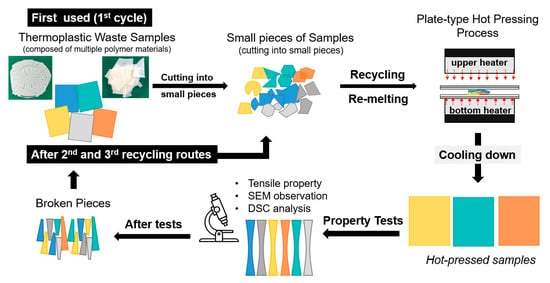
Figure 1.
Sample preparation and recycling routes of thermoplasticpolyurethane and polypropylene (T/P) and T/P/maleic anhydride (MA) waste-blended materials.

Table 1.
Parameters of T/P and T/P/MA blends in the hot-pressing process.
2.2. Preparation
In this study, the damage that resulted from the mechanical fractures and melting–recycling cycles of used T/P and T/P/MA waste-blended samples is evaluated, in which the plate-type hot-pressing method and tensile tests are employed as thermal breakage and mechanical breakage, respectively. As shown in Figure 1, the given T/P and T/P/MA blended samples are one-off mechanically damaged and then hot-pressed again, and the new T/P samples are denoted as the post-2nd-recycling group. The new blended samples are denoted as the post-3rd-recycling group when undergoing the aforementioned route again. For these two groups, recycling means a process that combines hot-pressing and mechanical fracture. Therefore, melt-recycling involves one-time hot-pressing, the post-2nd-recycling, and the post-3rd-recycling. Before conducting hot-pressing, six groups of samples were dried in an oven at 40 °C for 24 h in order to remove residual moisture. Next, the hot-pressing machine was preheated for one hour, and compounds were then placed on an aluminate plate and treated with a melting process for 3–5 min and then a pressing process for five minutes. Afterward, samples were cooled at room temperature (Figure 1). The blends were hot-pressed at a pressure of 20 MPa, and the specified thickness was 0.5 mm.
Table 1 demonstrates the corresponding hot-pressing temperatures for different blending ratios. A greater P content provides T/P/MA blends with a higher melting temperature. In contrast, the melting temperatures were 165 °C for P100 and 145 °C for T100.
2.3. Tests
2.3.1. SEM Observation
In this study, the fracture morphology of T/P and T/P/MA waste-blended samples with various conditions (as related to the number of hot-pressing cycles and the number of mechanical fractures) was observed by a scanning electron microscope (SEM, S4800, HITACHI, Tokyo, Japan). To observe the morphology of both blended groups, the SEM equipment was set a 3-kV voltage, with various magnifications [29]. Moreover, the influence of T/P and T/P/MA waste-blended samples with the presence of a compatibilizer on morphology and particle size was also examined.
2.3.2. Tensile Properties
As specified in ASTM D638-14, type IV samples were prepared with a dog-bone shape. A universal tester (Instron 5566, Instron, Norwood, MA, USA) was used to measure the tensile properties of the 0.5-mm thick T/P and T/P/MA waste-blended samples, including tensile stress at break, tensile strain at break, tensile stress at yield point, and tensile strain at yield point. The speed of testing was based on the specifications of the specimen type, and T/P and T/P/MA groups were classified as rigid and semirigid groups. Moreover, type IV samples were chosen to be tested at a speed of 5 mm/min [30]. Five samples for each specification were used to obtain the average value.
2.3.3. DSC Analysis
Differential scanning calorimetry (DSC) is a common measure to evaluate the thermophysical property of polymer materials. A blank specimen is referred to as the control. Samples are put in the heating system, and during the heating process, the thermal enthalpy (i.e., endothermic and exothermic enthalpy) is measured at a constant heating rate based on different temperatures. DSC analysis is used to evaluate the thermal properties related to two factors (the number of melting cycles and the number of mechanical fractures). In this study, T/P and T/P/MA blends were heated from 40 to 180 °C at an increment of 5 °C per minute and kept isothermal for 5 min at 180 °C. Moreover, the environment temperature was decreased from 40 to 180 °C at a decrement of 5 °C every minute. The melting and cooling loops were repeated for two cycles to remove the thermal history of the T/P and T/P/MA blends. Furthermore, DSC analysis was also used to evaluate the crystallization performance, as related to the presence of a compatibilizer, after the T/P and T/P/MA blends had undergone multiple thermal cycles [30].
3. Results and Discussion
Recycled thermoplastic T/P waste compounds were used in this study instead of individual thermoplastic polyurethane and polypropylene materials. Thermoplastic polyurethane (T) and polypropylene (P) possess different intrinsic features and, therefore, P is commonly used to strengthen the mechanical and thermal properties of T. The noticeable feature about thermoplastic materials is that they can be reshaped with an appropriate temperature. It is challenging to recycle thermoplastic waste compounds due to various intrinsic properties. This study mainly explores how to reuse polymer waste compounds and examines the reshaped materials in terms of morphological observation, thermal properties, and tensile properties. Additionally, the effect of the existence of a compatibilizer on the various aspects of T/P and T/P/MA waste blends will also be discussed after multiple melting–recycling cycles.
3.1. Surface Observation
3.1.1. Microscope Observation
Figure 2A,B shows the appearance variation of T/P blends and T/P/MA blends as related to the post-2nd and post-3rd recycling, respectively. In Figure 2A, blends that are composed of a greater T content appear in dark yellow, while blends that are composed of a greater P content appear in lighter yellow, according to the comparison between the images of T90 and T70. The yellowing phenomena can be ascribed to the oxidation reaction of thermoplastic polyurethane during the recycling processes [31,32]. Based on the results of melt-recycling, T/P/MA blends are more easily and efficiently hot-pressed than T/P blends (i.e., MA-free blends). As MA serves a bridging role that can improve the original interfacial property between T and P, it well attenuates the interfacial tension. It has been proven that a proper compatible agent for a multiple-polymer system is desirable, where the original system without a compatible agent was with poor performance and limited application [27]. Figure 2B shows that P100 and T100 waste-blended samples do not show distinct defects in the post-3rd-recycling process and still maintain good formability. It is a good piece of evidence that the thermoplastic materials can be well reformed within an appropriate treatment. At the same time, the MA-containing blends also have stable formability and can be hot-pressed efficiently. With a greater number of melting–recycling cycles, MA provides T/P matrices with significant compatibility and stability. As for MA-free blends, the images of T90, T70, and T50 in Figure 2B exhibit distinctive pores and defects. The phenomenon results from melting–recycling cycles, in which the variation of thermal energy may escalate the incompatibility and immiscibility between T and P. Moreover, phase separation becomes apparent and forms larger defects on the T/P blends with increasing content of polypropylene. Furthermore, the larger the content value difference between T and P, the more significant the differentiation effect. On the other hand, the MA-containing groups (T90/MA, T70/MA, and T50/MA) show a reverse result, where the presence of MA makes a contribution to stable formability regardless of multiple melting–recycling cycles, which suggests that the feasibility of multiple utilization is increased considerably.
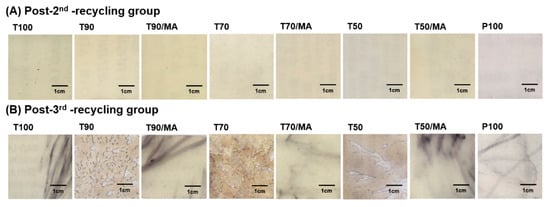
Figure 2.
Surface observation of T/P and T/P/MA blends as related to post-2nd and post-3rd recycling. (A) Post-2nd-recycling group; (B) post-3rd-recycling group.
3.1.2. SEM Observation
Figure 3A,B shows the fracture sections of post-2nd-recycling and post-3rd-recycling T/P/MA blends, respectively, after tensile tests. Figure 3A shows that T100 looks flatter and smoother than P100 because thermoplastic polyurethane is, comparatively, a more ductile material. Pure polypropylene reveals a homogeneous pattern, with a rough and flat surface that indicates a typical characteristic of tough fractures [33]. Figure 3B displays the surface roughness of P100 and T100 after the post-3rd-recycling process and further explains that thermoplastic materials require appropriate post-treatment when reforming. T100 shows an ascending trend on roughness, which is ascribed to the poor thermal stability of thermoplastic polyurethane. The multiple melting–recycling cycles result in damage on T100 to a certain extent, so the surface is no longer being sleek. Polar thermoplastic polyurethane and nonpolar polypropylene are incompatible and immiscible when blended with each other, and further lead to phase separation derived from high interfacial tension produced at interphase [34]. The Figure 3A group (T90, T70, and T50) shows that with greater polypropylene content, the blends yield more pores, which means, equivalently, that both the differentiation effect and incompatibility between thermoplastic polyurethane and polypropylene are strengthened. Figure 3B (T90, T70, and T50) demonstrates that with the employment of the post-3rd-recycling, thermoplastic polyurethane matrices are partially expanded, and polypropylene particles are wrapped in the matrices while the roughness is concurrently enhanced. Furthermore, the differentiation effect is clearly observed when comparing T70 and T50; the spherical particles in T50 blends appear prone to fall off from the pores due to enlarged interfacial tension and poor adhesion between thermoplastic polyurethane and polypropylene [33]. The Figure 3A group (T90/MA, T70/MA, and T50/MA) shows that the presence of MA stabilizes the morphology of all T/P/MA blends (i.e., MA-containing blends). Similarly, Figure 3B (T90/MA, T70/MA, and T50/MA) shows that MA improves the pores and defects triggered by the excessive interfacial tension between the thermoplastic polyurethane and polypropylene [33]. Moreover, the copolymer on the T/P interfaces prevents the occurring of coalescence. Comparing the MA-containing and MA-free groups, the former shows an attenuated differentiation effect. The results indicate that a proper introduction of compatibilizer improves the defects and reduces the differentiation effect caused by the diversity or blending ratio of the constituent materials.
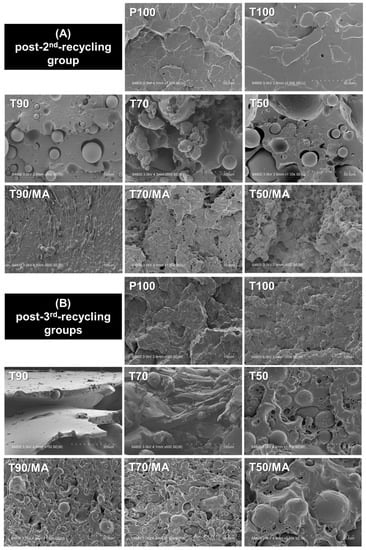
Figure 3.
SEM images of post-2nd-recycling and post-3rd-recycling T/P and T/P/MA blends. (A) Post-2nd-recycling group; (B) post-3rd-recycling group.
3.2. Tensile Properties
Figure 4 shows the stress–strain curves and stereomicroscopic images of T/P and T/P/MA blends after tensile test and the corresponding denotations are listed in Table 1. Figure 4A–C shows the tensile properties of T90, T70, and T50, as related to whether MA is added, namely, T90/MA, T70/MA, and T50/MA. Figure 4D shows the stereomicroscopic image of the expanded T/P blends. In Figure 4A–C, the black curve means samples are treated with one-off hot-pressing, while the red and blue curves, separately, mean samples are treated with post-2nd- and post-3rd-recycling and the resulting samples are compared, thereby examining the reclamation efficacy of T/P blends. Meanwhile, the solid lines represent the MA-free groups, while the dotted lines represent the 5 wt % MA-containing groups.
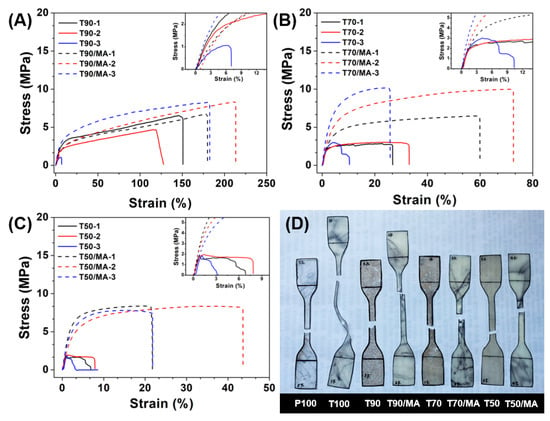
Figure 4.
Tensile performance of T/P and T/P/MA groups as related to the melting–recycling cycles: (A)–(C) stress–strain curves; (D) practical samples after tensile property tests. 1: one-off hot-pressing, 2: the post-2nd-recycling, and 3: the post-3rd-recycling.
Figure 4A and Table 2 show that T90 has decreasing tensile strength and strain as a result of the number of melting–recycling cycles, which is opposite to the 5 wt % MA-containing group that shows higher tensile performances. Compared to the post-2nd-recycling group, the tensile strength of T90 in the post-3rd-recycling group decreased by 78.6%, while T90/MA increased by 80.5%. Figure 4B,C shows that T70 and T50 have a marginal increase in tensile stress and strain when processed with post-2nd-recycling when comparing to first use. The results also show an obvious decrease in tensile stress and strain when processed with post-3rd-recycling. It is surmised that post-2nd-recycling makes thermoplastic polyurethane and polypropylene more evenly blended, but the 3rd time may cause unrecoverable breakage to T/P blends. The insets of Figure 4A–C show the tensile stress and strain of MA-free groups, which exhibit a drastic decrease as a result of the post-3rd-recycling. Moreover, increasing polypropylene content renders MA-free groups with a more significant differentiation effect that results from higher interfacial tension and poor adhesive performance. In particular, T50 displays the lowest tensile stress and strain, which is attributed to a rather low tensile strain of polypropylene, as well as the most remarkable differentiation effect between thermoplastic polyurethane and polypropylene. In sum, the presence of MA has a positive influence on the tensile properties of T/P/MA blends. From Figure 4B, the tensile strength of T70/MA-3 increased up to 9.2 MPa, and that of T70/MA-2 also reached 9.0 MPa. Figure 4C shows a slight decrease in tensile strength from T50/MA-2 to T50/MA-3, where maleic anhydride may have a lighter effect when the thermoplastic polyurethane and polypropylene are both half the content of the blends. Applying a maleic anhydride grafted copolymer as a compatibilizer is an efficient strategy in reactive compatibilization for incompatible polymer systems, where the diisocyanate group on the rigid segment of thermoplastic polyurethane reacts with the maleic anhydride group and forms a copolymer layer at the interphase of T/P during the melting and reheating process, as revealed in Figure 5 [4,35]. It can be found that the mechanical properties of blended thermoplastic materials are improved, even enhanced, with the introduction of an appropriate compatibilizer of proper content [1].

Table 2.
Tensile stress and tensile strain of post-2nd-recycling and post-3rd-recycling T/P and T/P/MA blends.

Figure 5.
The reacted chemical groups in each material during the recycling processes.
Table 2 summarizes the tensile stress at break, tensile strain at break, tensile stress at yield point, and tensile strain at yield point of the T/P blends. T100 and P100 both show a decreasing trend in tensile properties due to the conduct of post-3rd-recycling. P100 and T100 dropped by 19.4% and 21.2% in the post-3rd-recycling and post-2nd-recycling groups, respectively. Moreover, post-2nd-recycling T/P and T/P/MA blends have higher tensile properties than the post-3rd-recycling T/P and T/P/MA blends. It is indicated that although polypropylene has better thermal stability than thermoplastic polyurethane, less polypropylene content remains than thermally unstable thermoplastic polyurethane. Hence, the tensile performance of pure material groups become poor after multiple recycling cycles. At the same time, T/P/MA blends also demonstrate similar improvement. As MA improves the high interfacial tension and low compatibility between thermoplastic polyurethane and polypropylene, which are caused by a polarity difference, T/P/MA blends exhibit better tensile properties.
3.3. DSC Analysis
With constant pressure, the heat flow (Q) is equal to the enthalpy change (ΔH) as Equation (1).
The melting temperature (Tm) and melting enthalpy (ΔHm) for thermoplastic polyurethane are 145.8 °C and 9.7 J/g and for polypropylene 164.5 °C and 92.7 J/g. On the other hand, the crystallization temperature (Tc) and crystallization enthalpy (ΔHc) for thermoplastic polyurethane are 62.5 °C and 6.2 J/g, and for polypropylene 118.1 °C and 91.3 J/g.
Figure 6 shows the melting behaviors, including Tm and ΔHm of T/P/MA blends, while Figure 7 shows the crystallization behaviors, including crystallization temperature (Tc) and crystallization enthalpy (ΔHc). Figure 6A–C shows that with a rise in polypropylene content, T50 has the maximal melting enthalpy for polypropylene, which is a semi-crystalline polymer. However, thermoplastic polyurethane is an amorphous polymer, and hence, the yielded maximal melting enthalpy is primarily attributed to the presence of polypropylene. Based on the employment of melt-recycling, the melting enthalpy of samples undergoing one-off hot-pressing (Figure 6A) is higher than the melting enthalpy of the two batches of samples undergoing post-2nd-recycling (Figure 6B) and post-3rd-recycling (Figure 6C). Despite being thermoplastic polymers, both T and P still trigger a greater number of interactions among molecular chains due to the enthalpy variation. Subsequently, the molecular chains are exerted with influences or even damage, which adversely affects the stability of the entire structure [36].
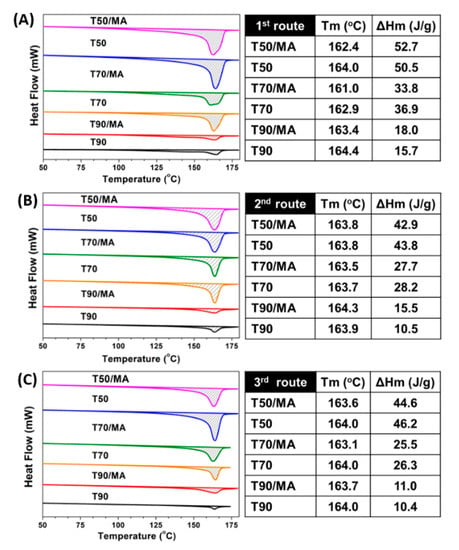
Figure 6.
Melting behaviors in the differential scanning calorimetry (DSC) performance of T/P and T/P/MA blends as related to melt-recycling: (A) one-off hot-pressing, (B) the post-2nd-recycling, and (C) the post-3rd-recycling. Tm = melting temperature and ΔHm = melting enthalpy.
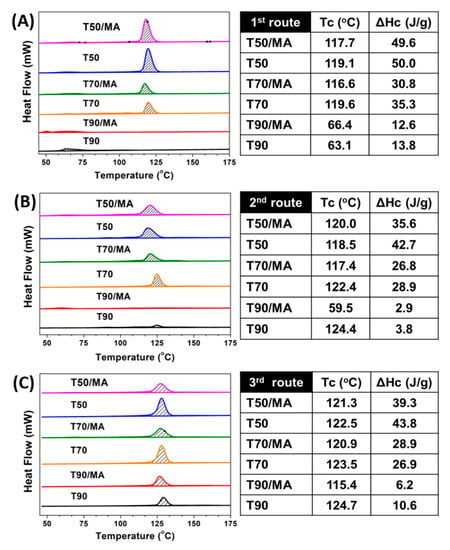
Figure 7.
Crystallization behaviors in DSC performance of T/P and T/P/MA groups as related to melt-recycling: (A) one-off hot-pressing, (B) the post-2nd-recycling, and (C) the post-3rd-recycling. Tc is crystallization temperature and ΔHc is crystallization enthalpy.
From Figure 7A,B, the crystallization curves of the T90 and T90/MA groups show small exothermic peaks around 60–70 °C, which are related to the disordered arrangement of rigid segments in thermoplastic polyurethane block copolymers [17]. Figure 7A–C shows that the T90 and T90/MA groups demonstrate insignificant crystallization peaks regardless of whether MA is added. On the other hand, increasing the polypropylene content provides the T70 and T50 groups with increasingly complete crystallization peaks, followed by a rise in crystallization enthalpy. Being an amorphous polymer, thermoplastic polyurethane has rather low intrinsic crystallization behavior. Thus, the deductive comparison confirms that the occurrence of the crystallization peak is owed to the presence of polypropylene. The interactions between polypropylene and thermoplastic polyurethane polymer chains lead to an increment in heat transition. Furthermore, as an increasing consequence of the presence of polypropylene crystallites in the thermoplastic polyurethane matrix, the crystallization rate of the T/P blended group increases [37]. Moreover, the addition of MA broadens the shapes of both melting peaks and crystallization peaks, which also suggests that either the heating process or cooling process demands more time to melt or generate crystals. In addition, MA-containing blends also have lower melting enthalpy or crystallization enthalpy than the MA-free blends. The urethane groups located in the rigid segment of thermoplastic polyurethane exhibit dissociation, and then have grafting reactions with the anhydride groups of MAs. As a result, the molecular chains from some crystal phases are entangled and, as such, limit the composition of the entire crystals, which eventually interferes with the difference in enthalpy.
3.4. Differentiation Effect
The differentiation effect is a quick and easy reference to consider the difference between incompatible or immiscible materials, which is affected by the polarity of each material. In this study, the differentiation effect of T/P blends, as related to the blending ratios, is examined. Based on the discussion of Section 3.1, Section 3.2 and Section 3.3, a rise in the melting cycles exacerbates the phase separation between thermoplastic polyurethane and polypropylene. When the filler content is less than 50 wt %, that is, the ratio of filler to the total content is close to 0.5, the differentiation effect is increasingly significant. Namely, the P/(T + P) ratio can be used as a reference to determine the differentiation effect with corresponding variations in the ratio. The ratio can be computed with Equation (2).
Based on the T/P ratios, samples can be divided into T90, T70, and T50. The incorporation of MA is precluded from the discussion on the differentiation effect. This equation is exclusively used for two incompatible and immiscible materials. MA is used in this study as a compatibilizer to attempt to mitigate the interfacial tension and phase separation. To sum up, the differentiation effect, from highest to lowest, can be ranked as T50, T70, and T90. Moreover, Figure 3, Figure 4, and Figure 6 indicate that with an increasing number of melting–recycling cycles, phase separation is more distinctive, which suggests that the differentiation effect is intensified.
4. Conclusions
In this study, the recycled T/P waste compounds are processed with one-off hot-pressing, post-2nd-recycling, and post-3rd-recycling to reform the blends. The T/P/MA blends were tested for tensile properties and thermal performance, as well as observed for morphology, thereby investigating the influences of the number of melting–recycling cycles and the presence of a compatibilizer. In light of the stereomicroscopic images, T/P/MA blends exhibited a darker yellow shade as a result of increasing the T content. Moreover, on the same premise, with multiple melt-recycling, MA-containing T/P/MA blends exhibited better integral formability than MA-free T/P blends and did not have pores or defects. The SEM images showed that the post-3rd-recycling T/P/MA blends had a higher roughness level than the post-2nd-recycling T/P/MA blends. In addition, MA-free and MA-containing groups separately exhibited a distinctive and mild differentiation effect. Furthermore, the post-2nd-recycling T/P/MA blends had higher tensile properties than the post-3rd-recycling T/P/MA blends. The presence of MA addresses the high interfacial tension and low compatibility caused by the polarity difference between T and P and provides the blends with better tensile properties. The differentiation effect of MA-free blends can be ranked from highest to lowest as T50, T70, and T90, and an increase in the number of melting–recycling cycles concurrently deteriorates the phase separation, which means, equivalently, a worsened differentiation effect. The purpose of this study is to efficiently use considerable waste plastic materials in order to achieve recycling efficacy with added value while sustaining environment protection.
Author Contributions
Writing—original draft preparation, T.A.L.; writing—review and editing, T.A.L.; supervision, L.B.; funding acquisition, J.-H.L. All authors have read and agreed to the published version of the manuscript.
Funding
This research was funded by the Ministry of Science and Technology of Taiwan, grant number MOST 108-2221-E-035-060-MY2.
Conflicts of Interest
The authors declare no conflict of interest.
References
- Ashwani, K.S.; Raman, B.; Balbir, S.K. Mechanical properties of composite materials based on waste plastic—A review. Mater. Today Proc. 2020, 26, 1293–1301. [Google Scholar]
- Faraca, G.; Astrup, T. Plastic waste from recycling centres: Characterisation and evaluation of plastic recyclability. Waste Manag. 2019, 95, 388–398. [Google Scholar] [CrossRef] [PubMed]
- Zare, Y. Recent progress on preparation and properties of nanocomposites from recycled polymers: A review. Waste Manag. 2013, 33, 598–604. [Google Scholar] [CrossRef] [PubMed]
- Maris, J.; Bourdon, S.; Brossard, J.M.; Cauret, L.; Fontaine, L.; Montembault, V. Mechanical recycling: Compatibilization of mixed thermoplastic wastes. Polym. Degrad. Stab. 2018, 147, 245–266. [Google Scholar] [CrossRef]
- Rubio-de Hita, P.; Perez-Galvez, F.; Morales-Conde, M.J.; Pedreno-Rojas, M.A. Reuse of plastic waste of mixed polypropylene as aggregate in mortars for the manufacture of pieces for restoring jack arch floors with timber beams. J. Clean. Prod. 2018, 198, 1515–1525. [Google Scholar] [CrossRef]
- Cousins, D.S.; Suzuki, Y.; Murray, R.E.; Samaniuk, J.R.; Stebner, A.P. Recycling glass fiber thermoplastic composites from wind turbine blades. J. Clean. Prod. 2019, 209, 1252–1263. [Google Scholar] [CrossRef]
- Kumi-Larbi, A.; Yunana, D.; Kamsouloum, P.; Webster, M.; Wilson, D.C.; Cheeseman, C. Recycling waste plastics in developing countries: Use of low-density polyethylene water sachets to form plastic bonded sand blocks. Waste Manag. 2018, 80, 112–118. [Google Scholar] [CrossRef]
- Steenkamer, D.A.; Sullivan, J.L. On the recyclability of a cyclic thermoplastic composite material. Compos. Part B Eng. 1998, 29, 745–752. [Google Scholar] [CrossRef]
- Sripornsawat, B.; Saiwari, S.; Nakason, C. Thermoplastic vulcanizates based on waste truck tire rubber and copolyester blends reinforced with carbon black. Waste Manag. 2018, 79, 638–646. [Google Scholar] [CrossRef]
- Othman, M.H. Polymer blends and composites from renewable resources. Encycl. Renew. Sustain. Mater. 2020, 5, 179–186. [Google Scholar] [CrossRef]
- Martinez-Urreaga, J.; Gonzalez-Sanchez, C.; Martinez-Aguirre, A.; Fonseca-Valero, C.; Acosta, J.; de la Orden, M.U. Sustainable eco-composites obtained from agricultural and urban waste plastic blends and residual cellulose fibers. J. Clean. Prod. 2015, 108, 377–384. [Google Scholar] [CrossRef]
- Frick, A.; Rochman, A. Characterization of TPU-elastomers by thermal analysis (DSC). Polym. Test. 2004, 23, 413–417. [Google Scholar] [CrossRef]
- Skrockiene, V.; Zukiene, K.; Jankauskaite, V.; Baltusnikas, A.; Petraitiene, S. Properties of mechanically recycled polycaprolactone-based thermoplastic polyurethane/polycaprolactone blends and their nanocomposites. J. Elastom. Plast. 2016, 48, 266–286. [Google Scholar] [CrossRef]
- Spirkova, M.; Brozova, L.; Hodan, J.; Kredatusova, J.; Krejcikova, S.; Zhigunov, A.; Pavlicevic, J. Recyclable polyurethane/nanoclay films. Polym. Compos. 2019, 40, 4079–4092. [Google Scholar] [CrossRef]
- Yuan, S.Q.; Bai, J.M.; Chua, C.K.; Zhou, K.; Wei, J. Characterization of creeping and shape memory effect in laser sintered thermoplastic polyurethane. J. Comput. Inf. Sci. Eng. 2016, 16, 041007. [Google Scholar] [CrossRef]
- Jiao, C.M.; Jiang, H.Z.; Chen, X.L. Reutilization of abandoned molecular sieve as flame retardant and smoke suppressant for thermoplastic polyurethane elastomer. J. Therm. Anal. Calorim. 2019, 138, 3905–3913. [Google Scholar] [CrossRef]
- Kunchimon, S.Z.; Tausif, M.; Goswami, P.; Cheung, V. Polyamide 6 and thermoplastic polyurethane recycled hybrid Fibres via twin-screw melt extrusion. J. Polym. Res. 2019, 26, 162. [Google Scholar] [CrossRef]
- Somdee, P.; Lassu-Kuknyo, T.; Konya, C.; Szabo, T.; Marossy, K. Thermal analysis of polyurethane elastomers matrix with different chain extender contents for thermal conductive application. J. Therm. Anal. Calorim. 2019, 138, 1003–1010. [Google Scholar] [CrossRef]
- Zhou, Q.Q.; Liu, C.K.; Zhou, K.Q.; Xuan, X.; Shi, C.L. Synergistic effect between solid wastes and intumescent flame retardant on flammability and smoke suppression of thermoplastic polyurethane composites. Polym. Advan. Technol. 2020, 31, 4–14. [Google Scholar] [CrossRef]
- Xiang, N.; Zhang, X.W.; Zheng, M.Y.; Ge, Y.; Wang, T.; Liu, H.B.; Maharaj, C.; Dear, J.P.; Yan, Y. Microstructure and tensile properties of injection molded thermoplastic polyurethane with different melt temperatures. J. Appl. Polym. Sci. 2020, 137, 48891. [Google Scholar] [CrossRef]
- Lee, Y.H.; Kang, B.K.; Kim, H.D.; Yoo, H.J.; Kim, J.S.; Huh, J.H.; Jung, Y.J.; Lee, D.J. Effect of hot pressing/melt mixing on the properties of thermoplastic polyurethane. Macromol. Res. 2009, 17, 616–622. [Google Scholar] [CrossRef]
- Lazim, N.H.; Samat, N. The influence of irradiated recycled polypropylene compatibilizer on the impact fracture behavior of recycled polypropylene/microcrystalline cellulose composites. Polym. Compos. 2019, 40, E24–E34. [Google Scholar] [CrossRef]
- Kiziltas, E.E.; Kiziltas, A.; Lee, E.C. Structure and properties of compatibilized recycled polypropylene/recycled polyamide 12 blends with cellulose fibers addition. Polym. Compos. 2018, 39, 3556–3563. [Google Scholar] [CrossRef]
- Yang, J.N.; Nie, S.B.; Huang, X.H.; Ding, G.X.; Zhu, J.B. Thermoplastic blends of PP and waste rubber powder: Effects of compatibilizer on tensile properties, thermal behavior and decomposition kinetics. Int. Polym. Proc. 2018, 33, 460–470. [Google Scholar] [CrossRef]
- Wirawan, R. Recyclability of natural fiber-filled thermoplastic composites. Encycl. Renew. Sustain. Mater. 2020, 5, 215–218. [Google Scholar] [CrossRef]
- Rajasekaran, D.; Maji, P.K. Recycling of plastic wastes with poly (ethylene-co-methacrylic acid) copolymer as compatibilizer and their conversion into high-end product. Waste Manag. 2018, 74, 135–143. [Google Scholar] [CrossRef] [PubMed]
- Chen, R.S.; Ahmad, S.; Gan, S. Characterization of recycled thermoplastics-based nanocomposites: Polymer-clay compatibility, blending procedure, processing condition, and clay content effects. Compos. Part B Eng. 2017, 131, 91–99. [Google Scholar] [CrossRef]
- Nagel, U.; Yang, L.; Kao, C.C.; Thomason, J.L. Effects of thermal recycling temperatures on the reinforcement potential of glass fibers. Polym. Compos. 2018, 39, 1032–1040. [Google Scholar] [CrossRef]
- Lin, T.R.; Lin, T.A.; Lin, M.C.; Lin, Y.Y.; Lou, C.W.; Lin, J.H. Impact resistance of fiber reinforced sandwich-structured nonwoven composites: Reinforcing effect of different fiber length. Mater. Today Commun. 2020, 24, 101345. [Google Scholar] [CrossRef]
- Lin, M.C.; Lin, J.H.; Lin, J.Y.; Lin, T.A.; Lou, C.W. Fabrication, properties, and failure of composite sandwiches made with sheet extrusion method. J. Sandw. Struct. Mater. 2020, 22, 689–701. [Google Scholar] [CrossRef]
- Boubakri, A.; Guermazi, N.; Elleuch, K.; Ayedi, H.F. Study of UV-aging of thermoplastic polyurethane material. Mater. Sci. Eng. A 2010, 527, 1649–1654. [Google Scholar] [CrossRef]
- Rosu, D.; Rosu, L.; Cascaval, C.N. IR-change and yellowing of polyurethane as a result of UV irradiation. Polym. Degrad. Stab. 2009, 94, 591–596. [Google Scholar] [CrossRef]
- Parameswaranpillai, J.; Joseph, G.; Jose, S.; Hameed, N. Phase morphology, thermomechanical, and crystallization behavior of uncompatibilized and PP-g-MAH compatibilized polypropylene/polystyrene blends. J. Appl. Polym. Sci. 2015, 132, 11. [Google Scholar] [CrossRef]
- Kunchimon, S.Z.; Tausif, M.; Goswami, P.; Cheung, V. From hybrid fibers to microfibers: The characteristics of polyamide 6/polypropylene blend via one-step twin-screw melt extrusion. Polym. Eng. Sci. 2020, 60, 690–699. [Google Scholar] [CrossRef]
- Lin, T.A.; Lin, J.H.; Bao, L.M. Polypropylene/thermoplastic polyurethane blends: Mechanical characterizations, recyclability and sustainable development of thermoplastic materials. J. Mater. Res. Technol. 2020, 9, 5304–5312. [Google Scholar] [CrossRef]
- Zaaba, N.F.; Ismail, H.; Jaafar, M. Recycled polypropylene/peanut shell powder (RPP/PSP) composites: Property comparison before and after electron beam irradiation. Polym. Compos. 2018, 39, 3048–3056. [Google Scholar] [CrossRef]
- Strankowski, M.; Strankowska, J.; Gazda, M.; Piszczyk, L.; Nowaczyk, G.; Jurga, S. Thermoplastic polyurethane/(organically modified montmorillonite) nanocomposites produced by in situ polymerization. Express Polym. Lett. 2012, 6, 610–619. [Google Scholar] [CrossRef]
© 2020 by the authors. Licensee MDPI, Basel, Switzerland. This article is an open access article distributed under the terms and conditions of the Creative Commons Attribution (CC BY) license (http://creativecommons.org/licenses/by/4.0/).